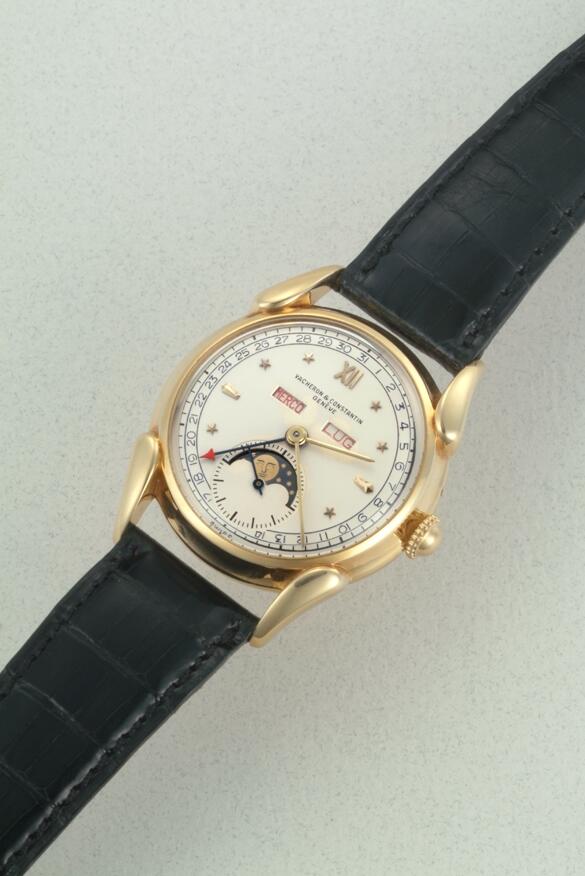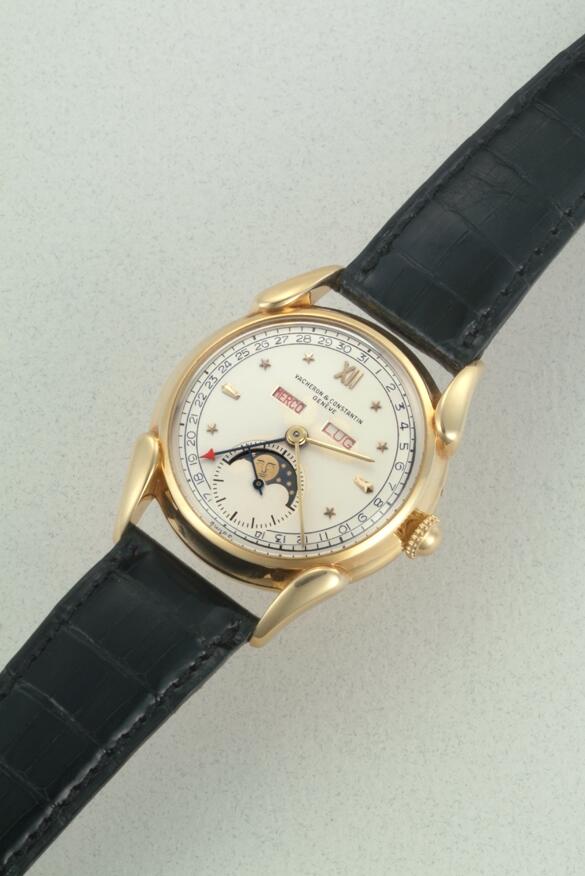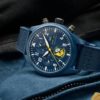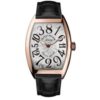From 24 January to 29 February 2020, fake Vacheron Constantin (founded in 1755, it is the oldest watchmaking manufacturer in the world with an uninterrupted activity of over 260 years) presents “VACHERON CONSTANTIN AND ITALY” retrospective of an uninterrupted history “, a exhibition of creations from the Maison’s heritage set up at Pisa Orologeria in Via Verri (the brand’s Milanese boutique); shows that I was lucky enough to be able to preview. It is an exhibition that I highly recommend. Thirteen creations dated between 1824 and 1979 that retrace the most significant stages of the relationship between the Geneva-based Maison and Italy, told through exceptional watchmaking. A love story, a liaison that dates back to the early 1800s and has never stopped. The exhibition opens with a decidedly symbolic 1824 creation, a yellow gold pocket watch with a silver dial and Roman numerals, decorated on the back with a map of Italy made with champlevé enamel, in bright blue and light blue tones. The exhibition includes 6 pocket watches: among others, the splendid 1905 model presented at the International Sempione Exhibition held in Milan in 1906, one of the pieces that earned the Maison the international jury award for quality and perfection. of its timepieces. The model is the “Chardon”, a yellow gold pocket watch with the back decorated with a floral motif of cloisonné enamel. The guilloché dial features 11 Arabic numerals, small seconds at 6 o’clock. Among the wristwatches, however, the 1950 model 4461 is noteworthy, a yellow gold timepiece with a complete calendar and moon phases: the dial of this creation is silver plated with Roman numerals and 12 star-shaped hour markers in yellow gold. The day of the week and the month can be read through two windows positioned between 12 o’clock and the center of the dial and are written in Italian. Introducing the contemporary collections, the famous “222“ model, the timepiece that inspired the birth of the Overseas collection, is on display.
Italy can be proud of its long watchmaking tradition. The exchanges between the Italian peninsula and Geneva had an important peak between the end of the 18th and the beginning of the 19th century, a period in which Vacheron Constantin and the Maison Bautte & Cie, for which François Constantin worked, became protagonists of the high-end sector. watchmaking. The archives of the Maison Vacheron Constantin preserve transactions dating back to 1812. With his passport Jacques-Barthélémy Vacheron, who had assumed a role in the family business, developed the trips to Italy touching the whole peninsula: Genoa, Venice or Turin were among the privileged destinations. He attended trade fairs to offer his watch repairing services and took the opportunity to present a part of his production. It was during these trips – often difficult and dangerous – that he met François Constantin, salesman of the Maison Bautte & Cie. Jacques-Barthélémy Vacheron, watchmaker with incredible technical skills – nephew of Jean-Marc Vacheron, founder of the Maison – and François Constantin, astute man businessman and intrepid traveler, united their talents in 1819. This meeting gave birth to the characteristic signature of the Maison, that is a subtle balance between watchmaking excellence and stylistic virtuosity, as well as to its motto: “Do better if possible, and it is always possible “. Jacques-Barthélémy would have been in charge of production in Geneva and François Constantin would have followed the commercial development abroad starting from Italy, a market that was very fond of fine watchmaking and that generated an interesting demand. The trips multiplied and soon became insufficient with respect to the growth of local demand. For this the Maison hired on-site representatives to sell the replica watches uk, a strategy that intensified between 1840 and 1850. In 1906 the Simplon International Exposition was held in Milan, the theme of the exhibition reflected the subject of its own emblematic manifesto designed by Leopoldo Metlicovitz, transport, celebrating the transalpine tunnel of the Simplon. The exhibition welcomed over 5 million visitors and 35,000 exhibitors from 40 countries including Vacheron Constantin who received the international jury award for the quality and perfection of its watches on that occasion. The collection on display included several models. At that time Vacheron Constantin delivered its timepieces in precious wooden caskets. By opening the box, the customer would have discovered the prizes the Maison obtained for the entire collection presented at the exhibition. These “advertising” boxes accompanied pocket watches in all countries. Exchanges with Italy allowed for precise information on which models were the most successful in addition to the customer profile which included some well-known names such as G.B. Pirelli (1872) or Pope Pius X who bought a silver watch in 1923.
Vacheron Constantin and Italy, the watches on display
1824, Pocket watch, yellow gold case, back of the case decorated with champlévé enamel depicting the map of Italy, guilloché silver dial with 12 Roman numerals, small seconds at 6 o’clock.
1837, Pocket watch, yellow gold case, back engraved with a marine scene, white enamel dial with 12 black enamel Roman numerals.
1905, Pocket watch, yellow gold case decorated with cloisonné enamel depicting a floral motif made up of thistles, guilloché silver dial with 11 Arabic numerals, small seconds dial at 6 o’clock. This watch was presented at the Milan International Exposition in 1906.
1908, Pocket watch, pink gold case, large and small strike and minute repeater mechanism, caseback decorated with enameled and polychrome emblem attributed to the Roman Salviati family, white enamel dial with 11 Arabic numerals, small seconds at 6 o’clock .
1929, Art Deco pocket watch, yellow gold and white gold case, case back decorated with black enamel monogram, jumping hour window at 12 o’clock, minutes indicated by a triangle-shaped black onyx hand, decorated silver dial with guilloché soleil motif, graduated outer minute circle with stylized Arabic numerals.
1941, Pocket watch, rose gold case, golden dial with gold indexes with double signature: “Vacheron Constantin, Genève and Gobbi, Milan”, small seconds at 6 o’clock. Personalized engraving inside the caseback “To Eng. Luigi Selmo the friends of Vizzola affectionately December 1953 ”. From the research carried out, Luigi Selmo was director and engineer of the hydraulic company SIP of the Lombardy Region.
1948, Model 4240 – Men’s wristwatch, complete calendar, rose gold case, gilt dial, Arabic numerals and indexes in rose gold, day of the week and month (in English) in aperture between 12 and center, circle external date in red, small seconds at 6 o’clock, leather strap and pin buckle in pink gold.
1950, Model 4461 – Men’s wristwatch, complete calendar with moon phase indication, yellow gold case, silvered dial with Roman numeral at 12 and yellow gold star indexes, day of the week and month windows (in Italian ) between 12 and center, blue outer date circle, moon phase indication and small seconds at 6 o’clock, outer minute circle, leather strap and pin buckle in yellow gold.
1953, Model 4907 – “Chronomètre Royal” men’s wristwatch, yellow gold case, central seconds with “stop balance” device, silver dial with yellow gold indexes, leather strap and yellow gold pin buckle.
1960, Model 6115 – Ultra-thin men’s wristwatch, yellow gold case, silver dial with golden indexes, leather strap with yellow gold pin buckle.
1962, Model 6440 – “Cioccolatone” men’s wristwatch with automatic winding with square case with rounded corners in rose gold, central seconds, sunray silver dial with rose gold indexes, inner circle of minutes. Leather strap with pink gold ardillon buckle.
1965, Model 4072 – Men’s chronograph wristwatch with 30 minutes counter, in yellow gold, gilt dial with yellow gold indexes, graduated pulsometric scale in French, 30 minutes counter at 3 o’clock and small seconds at 9 o’clock. in leather and pin buckle in yellow gold.
1979, Model 46003/411 – Collection “222” – Self-winding men’s wristwatch, yellow gold case. Slate gray dial with luminescent yellow gold indexes, hours, minutes and central seconds, date window at 3 o’clock, integrated bracelet in 18K yellow gold.



